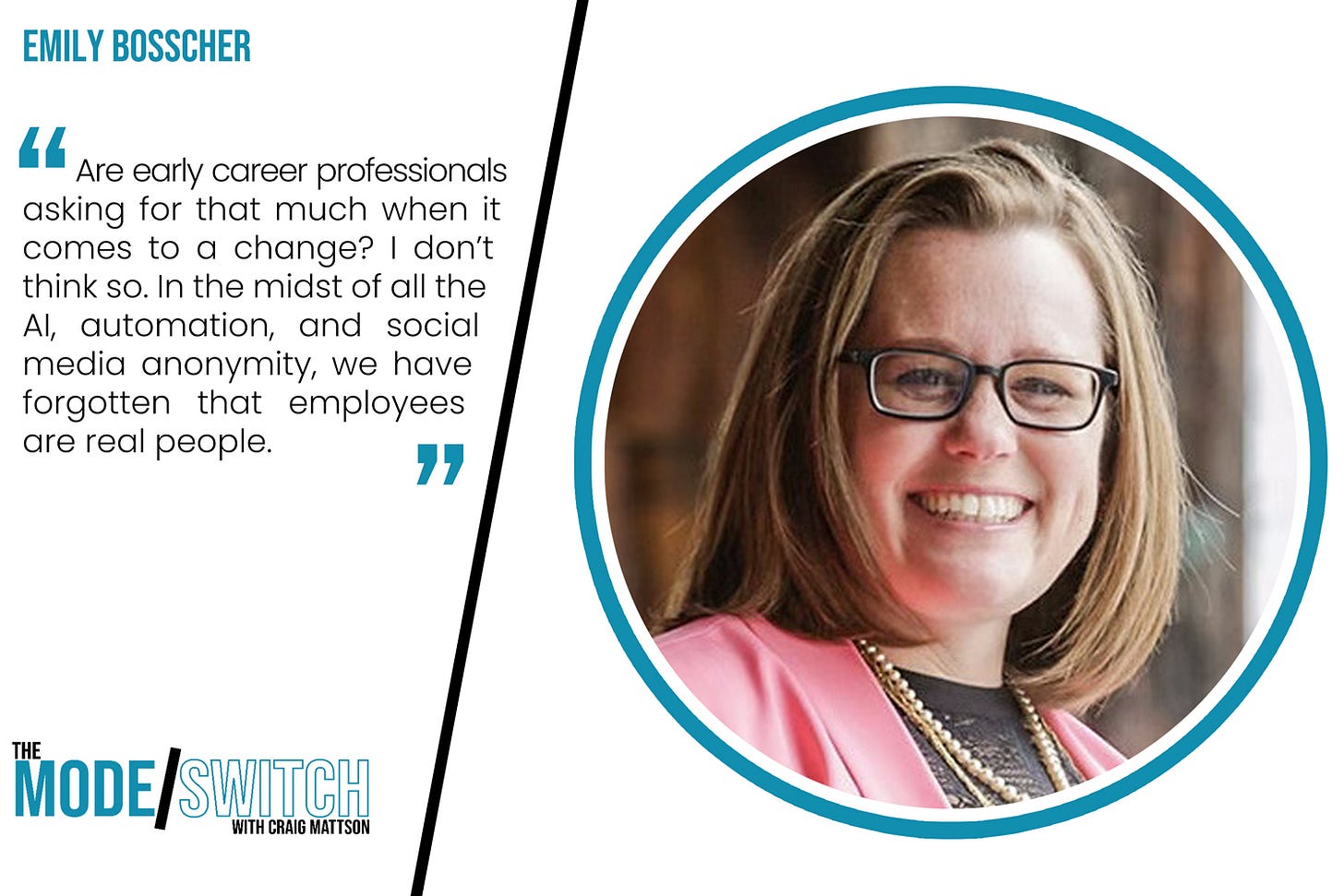Emily Bosscher’s guest post this week calls Gen Z and millennial professionals to “push past the awkwardness” to seek the mentoring they need and to learn the weirdness of a workplace’s culture. She and I sat down this morning and recorded fifteen minute’s worth of suggestions for how to do all that. Hope you’ll give her post below a read and the attached podcast a listen! Consider it mid-week bonus content. -craig
Young Professionals Aren’t Feeling Engaged at Work. Maybe It’s Not Their Engagement That Needs Addressing
There’s been some buzz recently about the decline of engagement among employees, particularly among early career professionals. A January 2023 Gallup Poll reported that only 32% of full- and part-time employees are engaged at work, while 18% are actively disengaged. Both categories had a 4% change since 2020…engagement 4% down and disengagement 4% up.
According to Kristen Parisi, reporter at HR Brew, “this disengagement comes from younger workers feeling less cared about, lacking someone who encourages their development, and feeling as though they have no opportunities to grow at work.”
You may have overheard managers asking? What’s wrong with these younger workers? Bad attitudes? Laziness? Incompetence? No grit?
Careful on the blame. I’d argue if companies are only seeing 32% of their employees engaged, that says something about the company, not just the employees. And honestly, is it wrong to want to be encouraged, cared about, and given opportunities?
No. So it might be time for a Mode/Switch.
Maybe it’s not rising professionals’ engagement that needs addressing but Gen Xers’ and Boomers’ leadership and mentoring.
Here’s what I mean. Supposedly, generations Millennial and Z were not taught the grit and resilience needed to stay engaged in the workplace. (You know, the so-called trophy generation.) But look, the latch-key generation and highly independent Boomers were taught resilience and independence and grit and hard work and stick-to-it-ness. (They also didn’t go to college during a world-wide pandemic.) And their experience has created the workplace expectations that you are wandering into.
Are you really asking for that much when it comes to a change? I don’t think so. The way I see it, in the midst of all the AI, automation, and social media anonymity, we have forgotten that employees are real people, and real people need care. That means seasoned professionals need to tend the gaps that exist between where you are and where company leadership thinks you should be.
Three main gaps are causing disengagement:
Isolation and Invitation Gaps
You are recovering from three years’ isolation. You need an intentional invitation into the life of the office, simply because you’ve never been part of one before. This means specific invitations to discuss office policies, from breaks to clothing to happy hours to interpersonal relationships. Managers should invite early careerists…
…to partake in the goodies in the break room.
….to know one another in the office (yes, maybe take a break for a few minutes!)
…to eat lunch with others rather than going out to their cars (I’ve seen how the awkwardness of not knowing what to do sends young employees into the total isolation of choking down a PB&J in the front seat of their vehicle while scrolling through IG).
You need a way into community rhythms, expectations, and culture. If you are working remotely, those invitations might need to be creative. But everybody needs to be invited into the office culture.
Mental and Emotional Gaps
For the entire workforce during the pandemic, mental and emotional health struggles increased. However, Generation Zers have been reporting increased levels of emotional and mental health concerns long before Covid, which just compounded everything. There will be gaps for new employees in terms of healthy and balanced mental capacity. One response I get a lot when I say this to employers is that these young ‘uns are “snowflakes.” I get that there are generational lapses in understanding mental health behavior and treatment, but mental health issues are not new. Maybe they are newly addressed in the workplace and dealt with in better, healthier ways, but they are not new. Foster a culture of policy review relating to mental health care, practice clear communication about wellness, and engagement will improve.
Belonging, Diversity, Equity, and Inclusion Gaps
The third category of gaps is in Diversity, Equity, and Inclusion (and, thanks to the work of Brené Brown, we add Belonging to that list). You are leaving college amidst the growing foment of the past three years in this country. Generational research tells us that you want to make a difference and work at companies taking a clear stand as changemakers. But in-person conversations and copy-machine interactions on these topics can be tricky. You might have questions like these:
· How to engage in workplaces if they fear their beliefs or opinions will make them a target of ridicule or aggression…
· How to navigate spaces and meetings when office décor includes both graphic phrases of disrespect for opposing political groups (no “side” is innocent of this)…
·. How to make ally statements like “Black Lives Matter” or the LGBTQ+ flag or pronouns in email signatures work in office culture…
Communication must be explicit, direct, and unequivocal when it comes to these BDEI questions. Employers should not be surprised to get a visit from you, asking (even demanding) something be done. And you should be listened to. Really.
Engagement is never unidirectional. If you are demotivated and disengaged, it’s time to Mode/Switch. Push past the awkwardness! Ask for these gaps to be filled!
-emily





